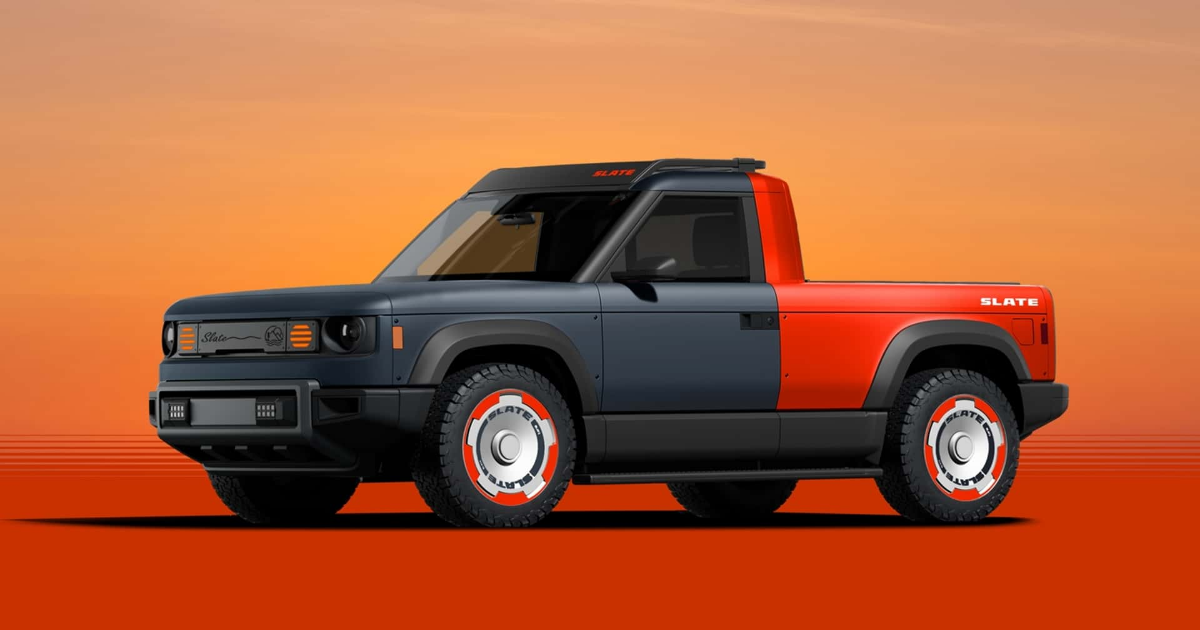Slate dropped a bombshell this week when it revealed both itself and its first model: a utilitarian electric pickup truck expected to cost under $20,000 after factoring in the federal tax credit for plug-in cars.
Cheap electric vehicles have been elusive for years, in part because EV batteries have historically been so expensive. So this truck could be a very big deal once production starts in late 2026—if Slate can avoid the pitfalls that tanked other EV startups.
Given the whole battery-cost hurdle, you might expect the startup’s pickup to use lithium-iron-phosphate (LFP) cells, a chemistry that’s gaining traction worldwide thanks to its lower cost. You’d be wrong. Slate is going with pricier and more typical nickel-manganese-cobalt (NMC) batteries.
Photo by: Slate
Chris Barman, Slate’s CEO, told InsideEVs it came down to where the supply chains for these two chemistries are located. She explained it would’ve been challenging to comply with the EV tax credit’s battery-sourcing requirements while using LFP.
“We’ve gone with more of what’s in the mainstream right now and that many others in the industry are using. So we’re using more of what’s been scaled within the U.S.,” she said. “For LFP, most of those materials would come out of China or elsewhere.”
The $7,500 federal rebate for EV buyers is a key driver of Slate’s price proposition, especially given how bare-bones its truck is before options. (It sports crank windows, no radio and a 150-mile range.) But the incentive isn’t available for buyers of just any vehicle. EVs need to be produced in North America. Slate’s got that covered with a factory opening up somewhere in the Midwest.
Photo by: Slate
And the battery pack that powers a qualifying vehicle can’t use components or critical minerals that come from a “foreign entity of concern,” which is government-speak for adversaries like China. The rules, passed during the Biden administration, aim to spur more domestic EV and battery manufacturing, while also making the car industry less reliant on China. That country has a stranglehold on global battery production. By some estimates, it’s responsible for 98% of the world’s supply of active materials for LFP batteries.
On top of that, battery cells need to meet requirements for both their components and raw materials that get stricter each year throughout this decade. By 2029, 100% of a qualifying vehicle’s battery components must be made in North America. By 2027, 80% of an EV battery’s critical minerals must be recycled in North America, come from the U.S. or come from a country the U.S. has a free-trade agreement with.
Photo by: Tim Levin/InsideEVs
It’s a lot to deal with. But Slate has the advantage of being able to set up its supply chains with these rules already in place. As the requirements have tightened up, manufacturers with EVs already on the road have had to scramble to remain compliant, with some models losing tax-credit eligibility altogether.
Of course, there’s also no guarantee the EV tax credit will remain on the books much longer. President Trump and his allies in Congress have proposed killing the subsidy.
At the end of the day, Slate went with U.S.-made NMC cells from the South Korean battery manufacturer SK On. The automaker inked an initial deal to purchase 20 gigawatt-hours of battery cells through 2031. That adds up to around 380,000 of its 52.7-kilowatt-hour packs. (Slate will also offer a larger 84.3-kWh pack with extra range.)
Photo by: InsideEVs
Another reason Slate went with NMC was its superior energy density. LFP packs are durable, known for their fast-charging abilities and use cheaper raw materials. But an NMC pack that takes up the same amount of space will generally deliver more range.
Eric Keipper, Slate’s head of engineering, said the automaker could’ve managed the 150-mile range of its base vehicle with LFP cells. But energy density would’ve been a problem for the longer-range, 240-mile version. That makes sense, given that the Slate truck is pretty tiny and there’s only so much space in the floor for battery cells.
“We wouldn’t have necessarily been able to get the energy density with LFP. So that was one of the factors,” he told InsideEVs, when asked about the decision between the two chemistries. “But really it’s the availability in the United States.”
Got a tip about the EV world? Contact the author: [email protected]
More On Slate’s Truck
Got a tip for us? Email: [email protected]
